Home Based Childcare Report: Roles, Responsibilities, and Well-being
VerifiedAdded on 2020/02/03
|14
|4920
|211
Report
AI Summary
This report delves into the multifaceted aspects of home-based childcare, encompassing the roles and responsibilities of childcarers, their impact on equality and diversity, and strategies for fostering children's well-being. It explores planning to meet the needs of children aged 0-7 and 7+, encouraging healthy eating habits, and addressing special dietary requirements. The report also examines partnerships with parents/carers, emphasizing the benefits of collaboration and maintaining confidentiality. Furthermore, it discusses areas of learning and development, factors influencing child development and behavior, key developmental milestones, and strategies for managing behavior. The report also covers the rights of children, the importance of play, and the need for an inclusive approach. Finally, it highlights the value of observation in understanding children and the role of early intervention in supporting their development.
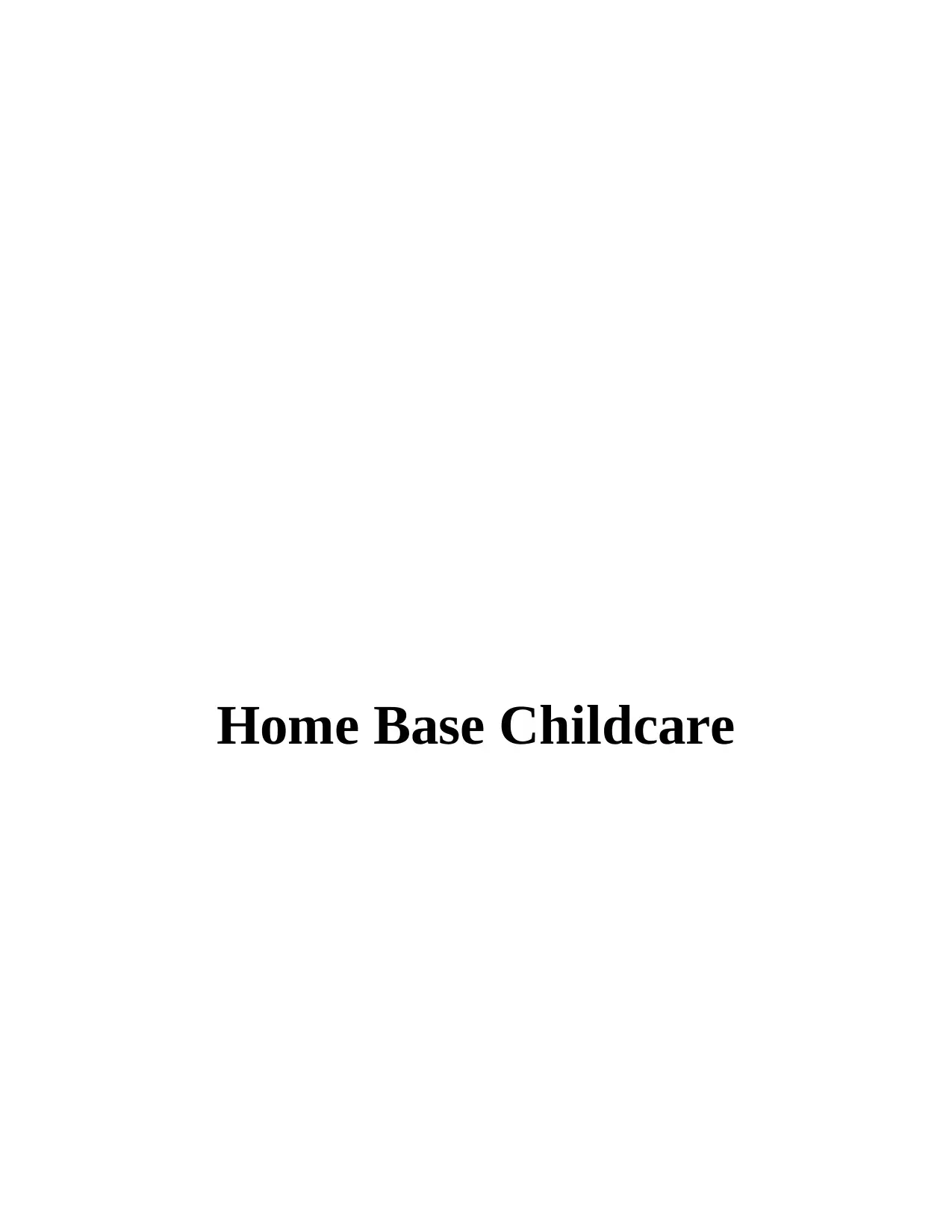
Home Base Childcare
Paraphrase This Document
Need a fresh take? Get an instant paraphrase of this document with our AI Paraphraser
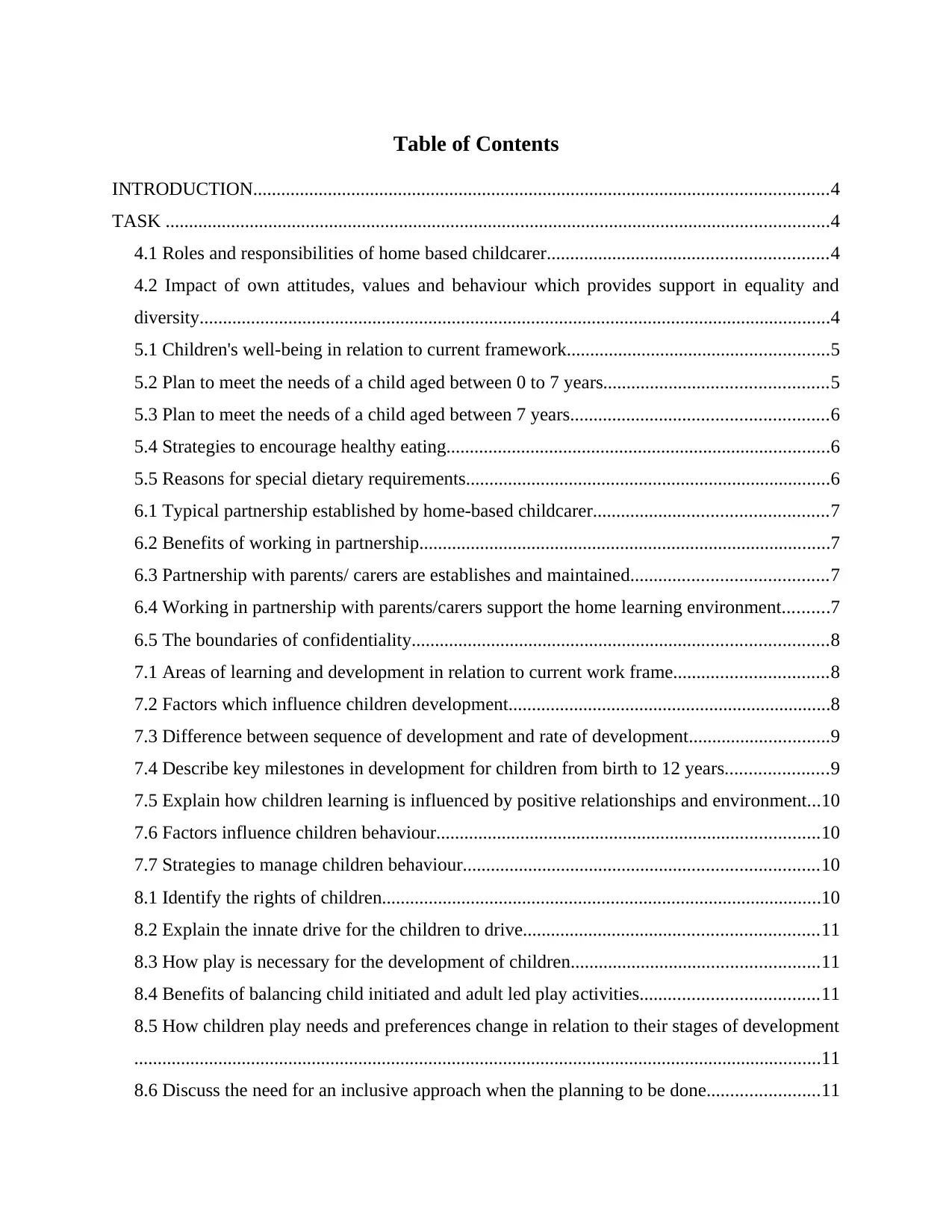
Table of Contents
INTRODUCTION...........................................................................................................................4
TASK ..............................................................................................................................................4
4.1 Roles and responsibilities of home based childcarer............................................................4
4.2 Impact of own attitudes, values and behaviour which provides support in equality and
diversity.......................................................................................................................................4
5.1 Children's well-being in relation to current framework........................................................5
5.2 Plan to meet the needs of a child aged between 0 to 7 years................................................5
5.3 Plan to meet the needs of a child aged between 7 years.......................................................6
5.4 Strategies to encourage healthy eating..................................................................................6
5.5 Reasons for special dietary requirements..............................................................................6
6.1 Typical partnership established by home-based childcarer..................................................7
6.2 Benefits of working in partnership........................................................................................7
6.3 Partnership with parents/ carers are establishes and maintained..........................................7
6.4 Working in partnership with parents/carers support the home learning environment..........7
6.5 The boundaries of confidentiality.........................................................................................8
7.1 Areas of learning and development in relation to current work frame.................................8
7.2 Factors which influence children development.....................................................................8
7.3 Difference between sequence of development and rate of development..............................9
7.4 Describe key milestones in development for children from birth to 12 years......................9
7.5 Explain how children learning is influenced by positive relationships and environment...10
7.6 Factors influence children behaviour..................................................................................10
7.7 Strategies to manage children behaviour............................................................................10
8.1 Identify the rights of children..............................................................................................10
8.2 Explain the innate drive for the children to drive...............................................................11
8.3 How play is necessary for the development of children.....................................................11
8.4 Benefits of balancing child initiated and adult led play activities......................................11
8.5 How children play needs and preferences change in relation to their stages of development
...................................................................................................................................................11
8.6 Discuss the need for an inclusive approach when the planning to be done........................11
INTRODUCTION...........................................................................................................................4
TASK ..............................................................................................................................................4
4.1 Roles and responsibilities of home based childcarer............................................................4
4.2 Impact of own attitudes, values and behaviour which provides support in equality and
diversity.......................................................................................................................................4
5.1 Children's well-being in relation to current framework........................................................5
5.2 Plan to meet the needs of a child aged between 0 to 7 years................................................5
5.3 Plan to meet the needs of a child aged between 7 years.......................................................6
5.4 Strategies to encourage healthy eating..................................................................................6
5.5 Reasons for special dietary requirements..............................................................................6
6.1 Typical partnership established by home-based childcarer..................................................7
6.2 Benefits of working in partnership........................................................................................7
6.3 Partnership with parents/ carers are establishes and maintained..........................................7
6.4 Working in partnership with parents/carers support the home learning environment..........7
6.5 The boundaries of confidentiality.........................................................................................8
7.1 Areas of learning and development in relation to current work frame.................................8
7.2 Factors which influence children development.....................................................................8
7.3 Difference between sequence of development and rate of development..............................9
7.4 Describe key milestones in development for children from birth to 12 years......................9
7.5 Explain how children learning is influenced by positive relationships and environment...10
7.6 Factors influence children behaviour..................................................................................10
7.7 Strategies to manage children behaviour............................................................................10
8.1 Identify the rights of children..............................................................................................10
8.2 Explain the innate drive for the children to drive...............................................................11
8.3 How play is necessary for the development of children.....................................................11
8.4 Benefits of balancing child initiated and adult led play activities......................................11
8.5 How children play needs and preferences change in relation to their stages of development
...................................................................................................................................................11
8.6 Discuss the need for an inclusive approach when the planning to be done........................11
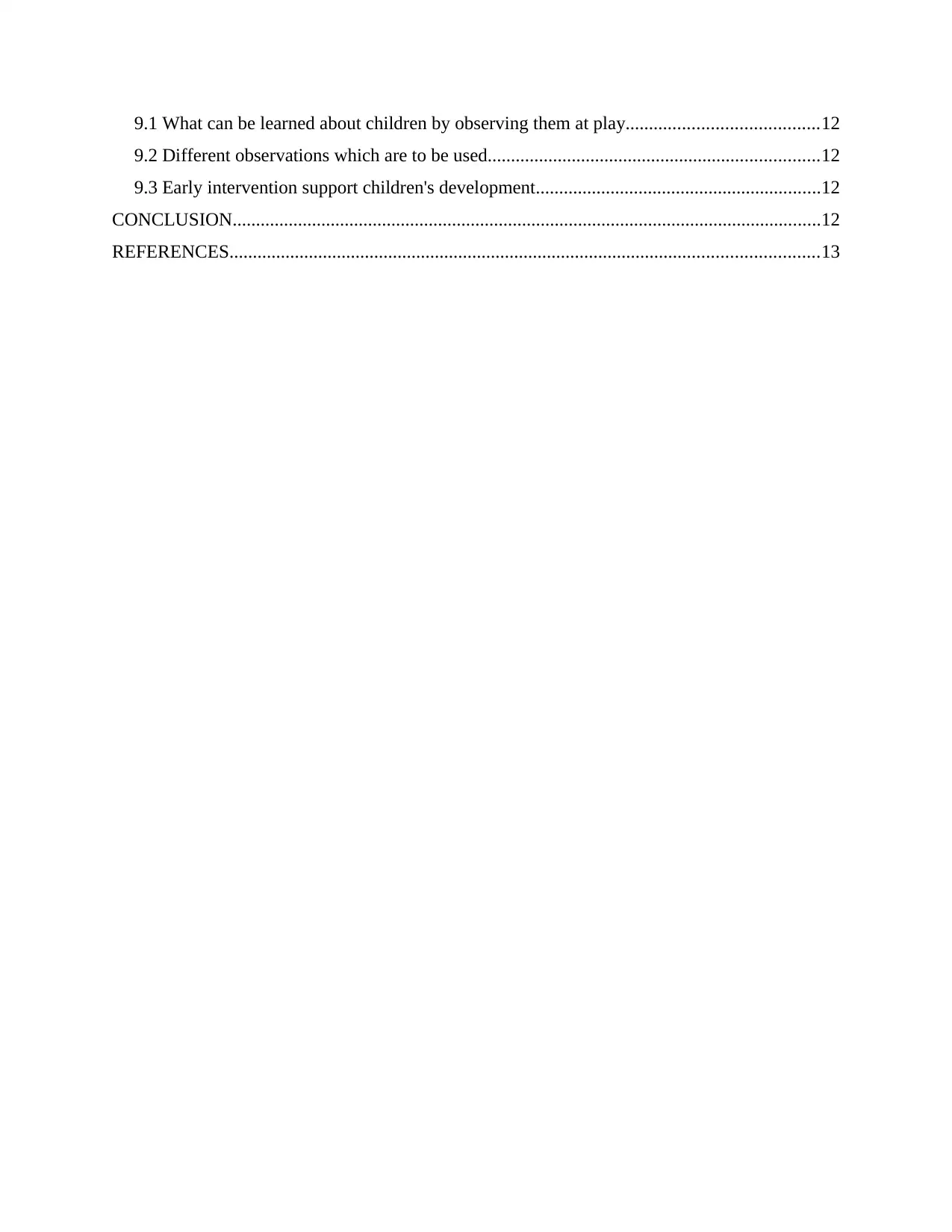
9.1 What can be learned about children by observing them at play.........................................12
9.2 Different observations which are to be used.......................................................................12
9.3 Early intervention support children's development.............................................................12
CONCLUSION..............................................................................................................................12
REFERENCES..............................................................................................................................13
9.2 Different observations which are to be used.......................................................................12
9.3 Early intervention support children's development.............................................................12
CONCLUSION..............................................................................................................................12
REFERENCES..............................................................................................................................13
⊘ This is a preview!⊘
Do you want full access?
Subscribe today to unlock all pages.

Trusted by 1+ million students worldwide
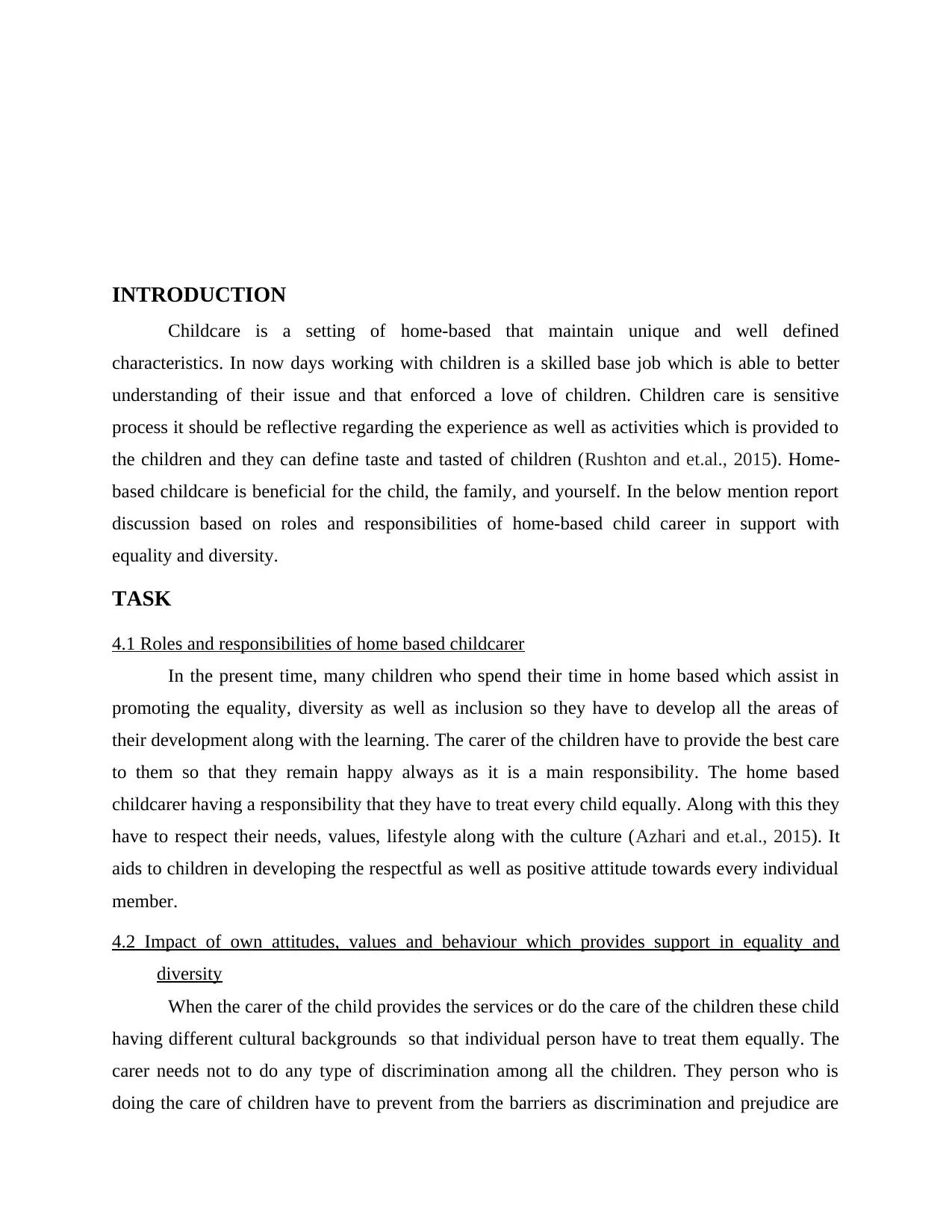
INTRODUCTION
Childcare is a setting of home-based that maintain unique and well defined
characteristics. In now days working with children is a skilled base job which is able to better
understanding of their issue and that enforced a love of children. Children care is sensitive
process it should be reflective regarding the experience as well as activities which is provided to
the children and they can define taste and tasted of children (Rushton and et.al., 2015). Home-
based childcare is beneficial for the child, the family, and yourself. In the below mention report
discussion based on roles and responsibilities of home-based child career in support with
equality and diversity.
TASK
4.1 Roles and responsibilities of home based childcarer
In the present time, many children who spend their time in home based which assist in
promoting the equality, diversity as well as inclusion so they have to develop all the areas of
their development along with the learning. The carer of the children have to provide the best care
to them so that they remain happy always as it is a main responsibility. The home based
childcarer having a responsibility that they have to treat every child equally. Along with this they
have to respect their needs, values, lifestyle along with the culture (Azhari and et.al., 2015). It
aids to children in developing the respectful as well as positive attitude towards every individual
member.
4.2 Impact of own attitudes, values and behaviour which provides support in equality and
diversity
When the carer of the child provides the services or do the care of the children these child
having different cultural backgrounds so that individual person have to treat them equally. The
carer needs not to do any type of discrimination among all the children. They person who is
doing the care of children have to prevent from the barriers as discrimination and prejudice are
Childcare is a setting of home-based that maintain unique and well defined
characteristics. In now days working with children is a skilled base job which is able to better
understanding of their issue and that enforced a love of children. Children care is sensitive
process it should be reflective regarding the experience as well as activities which is provided to
the children and they can define taste and tasted of children (Rushton and et.al., 2015). Home-
based childcare is beneficial for the child, the family, and yourself. In the below mention report
discussion based on roles and responsibilities of home-based child career in support with
equality and diversity.
TASK
4.1 Roles and responsibilities of home based childcarer
In the present time, many children who spend their time in home based which assist in
promoting the equality, diversity as well as inclusion so they have to develop all the areas of
their development along with the learning. The carer of the children have to provide the best care
to them so that they remain happy always as it is a main responsibility. The home based
childcarer having a responsibility that they have to treat every child equally. Along with this they
have to respect their needs, values, lifestyle along with the culture (Azhari and et.al., 2015). It
aids to children in developing the respectful as well as positive attitude towards every individual
member.
4.2 Impact of own attitudes, values and behaviour which provides support in equality and
diversity
When the carer of the child provides the services or do the care of the children these child
having different cultural backgrounds so that individual person have to treat them equally. The
carer needs not to do any type of discrimination among all the children. They person who is
doing the care of children have to prevent from the barriers as discrimination and prejudice are
Paraphrase This Document
Need a fresh take? Get an instant paraphrase of this document with our AI Paraphraser
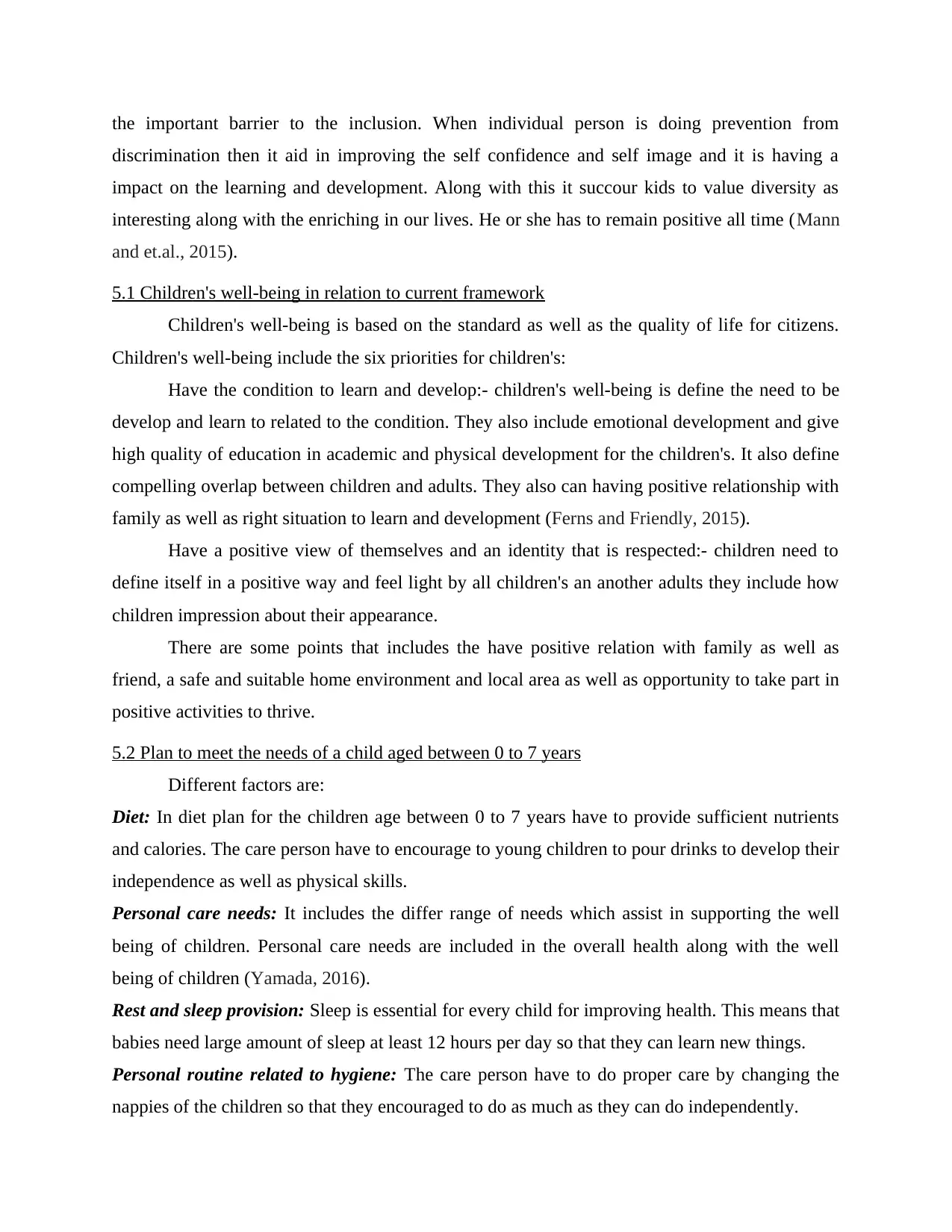
the important barrier to the inclusion. When individual person is doing prevention from
discrimination then it aid in improving the self confidence and self image and it is having a
impact on the learning and development. Along with this it succour kids to value diversity as
interesting along with the enriching in our lives. He or she has to remain positive all time (Mann
and et.al., 2015).
5.1 Children's well-being in relation to current framework
Children's well-being is based on the standard as well as the quality of life for citizens.
Children's well-being include the six priorities for children's:
Have the condition to learn and develop:- children's well-being is define the need to be
develop and learn to related to the condition. They also include emotional development and give
high quality of education in academic and physical development for the children's. It also define
compelling overlap between children and adults. They also can having positive relationship with
family as well as right situation to learn and development (Ferns and Friendly, 2015).
Have a positive view of themselves and an identity that is respected:- children need to
define itself in a positive way and feel light by all children's an another adults they include how
children impression about their appearance.
There are some points that includes the have positive relation with family as well as
friend, a safe and suitable home environment and local area as well as opportunity to take part in
positive activities to thrive.
5.2 Plan to meet the needs of a child aged between 0 to 7 years
Different factors are:
Diet: In diet plan for the children age between 0 to 7 years have to provide sufficient nutrients
and calories. The care person have to encourage to young children to pour drinks to develop their
independence as well as physical skills.
Personal care needs: It includes the differ range of needs which assist in supporting the well
being of children. Personal care needs are included in the overall health along with the well
being of children (Yamada, 2016).
Rest and sleep provision: Sleep is essential for every child for improving health. This means that
babies need large amount of sleep at least 12 hours per day so that they can learn new things.
Personal routine related to hygiene: The care person have to do proper care by changing the
nappies of the children so that they encouraged to do as much as they can do independently.
discrimination then it aid in improving the self confidence and self image and it is having a
impact on the learning and development. Along with this it succour kids to value diversity as
interesting along with the enriching in our lives. He or she has to remain positive all time (Mann
and et.al., 2015).
5.1 Children's well-being in relation to current framework
Children's well-being is based on the standard as well as the quality of life for citizens.
Children's well-being include the six priorities for children's:
Have the condition to learn and develop:- children's well-being is define the need to be
develop and learn to related to the condition. They also include emotional development and give
high quality of education in academic and physical development for the children's. It also define
compelling overlap between children and adults. They also can having positive relationship with
family as well as right situation to learn and development (Ferns and Friendly, 2015).
Have a positive view of themselves and an identity that is respected:- children need to
define itself in a positive way and feel light by all children's an another adults they include how
children impression about their appearance.
There are some points that includes the have positive relation with family as well as
friend, a safe and suitable home environment and local area as well as opportunity to take part in
positive activities to thrive.
5.2 Plan to meet the needs of a child aged between 0 to 7 years
Different factors are:
Diet: In diet plan for the children age between 0 to 7 years have to provide sufficient nutrients
and calories. The care person have to encourage to young children to pour drinks to develop their
independence as well as physical skills.
Personal care needs: It includes the differ range of needs which assist in supporting the well
being of children. Personal care needs are included in the overall health along with the well
being of children (Yamada, 2016).
Rest and sleep provision: Sleep is essential for every child for improving health. This means that
babies need large amount of sleep at least 12 hours per day so that they can learn new things.
Personal routine related to hygiene: The care person have to do proper care by changing the
nappies of the children so that they encouraged to do as much as they can do independently.

5.3 Plan to meet the needs of a child aged between 7 years
Different factors are:-
Diet: School age children are growing rapidly and they are very active in nature. It is better that
they can take small and frequent meals in a day which assist in providing energy to them.
Personal care needs: At the age of seven, children are fully independent in their routines when
they are doing the personal care which assist in hinder or foster their developments or
improvements. Along with this they have to wash their hands to remove the bacteria which
having a impact on their health (Weber, 2016).
Rest and sleep provision: Children who do not have sufficient rest and sleep which may display
the symptoms of hyperactive behaviour.
Personal and hygiene routines: All children having a right to privacy so that they can maintain
the relation to the personal hygiene routines.
5.4 Strategies to encourage healthy eating
The person who are doing the care of the different children they have to provide the
balanced as well as nutritious diet. It includes the variety of the foods but when it is offered it is
not like anyone. Every children having their likes and dislikes. Moreover, it can be changes time
to time. In the children, obesity and diet related disorder which is to be increased. The main key
to encourage the healthy eating in the children so that they get involved in this and show their
interest in eating a food. Healthy eating can be encouraged by having the foods with lots of
different colours, textures, smells as well as tastes (Luchini, Lee and Donovan, 2016).
5.5 Reasons for special dietary requirements
Dietary requirements is necessary and they are related to culture, religious beliefs as well
as ethnicity and medical conditions. By taking the diet some children have allergies by eating
some food. Along with this there are eight type of foods which can cause some allergic reaction
that is peanuts, cereals, milk, fish, egg etc. So, they have to eat those type of food which do not
create a allergic reaction on children. Some families have to follow diets that are ethical as well
as they create environmental awareness and that is organic in nature (Ang, Brooker and Stephen,
2016).
Different factors are:-
Diet: School age children are growing rapidly and they are very active in nature. It is better that
they can take small and frequent meals in a day which assist in providing energy to them.
Personal care needs: At the age of seven, children are fully independent in their routines when
they are doing the personal care which assist in hinder or foster their developments or
improvements. Along with this they have to wash their hands to remove the bacteria which
having a impact on their health (Weber, 2016).
Rest and sleep provision: Children who do not have sufficient rest and sleep which may display
the symptoms of hyperactive behaviour.
Personal and hygiene routines: All children having a right to privacy so that they can maintain
the relation to the personal hygiene routines.
5.4 Strategies to encourage healthy eating
The person who are doing the care of the different children they have to provide the
balanced as well as nutritious diet. It includes the variety of the foods but when it is offered it is
not like anyone. Every children having their likes and dislikes. Moreover, it can be changes time
to time. In the children, obesity and diet related disorder which is to be increased. The main key
to encourage the healthy eating in the children so that they get involved in this and show their
interest in eating a food. Healthy eating can be encouraged by having the foods with lots of
different colours, textures, smells as well as tastes (Luchini, Lee and Donovan, 2016).
5.5 Reasons for special dietary requirements
Dietary requirements is necessary and they are related to culture, religious beliefs as well
as ethnicity and medical conditions. By taking the diet some children have allergies by eating
some food. Along with this there are eight type of foods which can cause some allergic reaction
that is peanuts, cereals, milk, fish, egg etc. So, they have to eat those type of food which do not
create a allergic reaction on children. Some families have to follow diets that are ethical as well
as they create environmental awareness and that is organic in nature (Ang, Brooker and Stephen,
2016).
⊘ This is a preview!⊘
Do you want full access?
Subscribe today to unlock all pages.

Trusted by 1+ million students worldwide
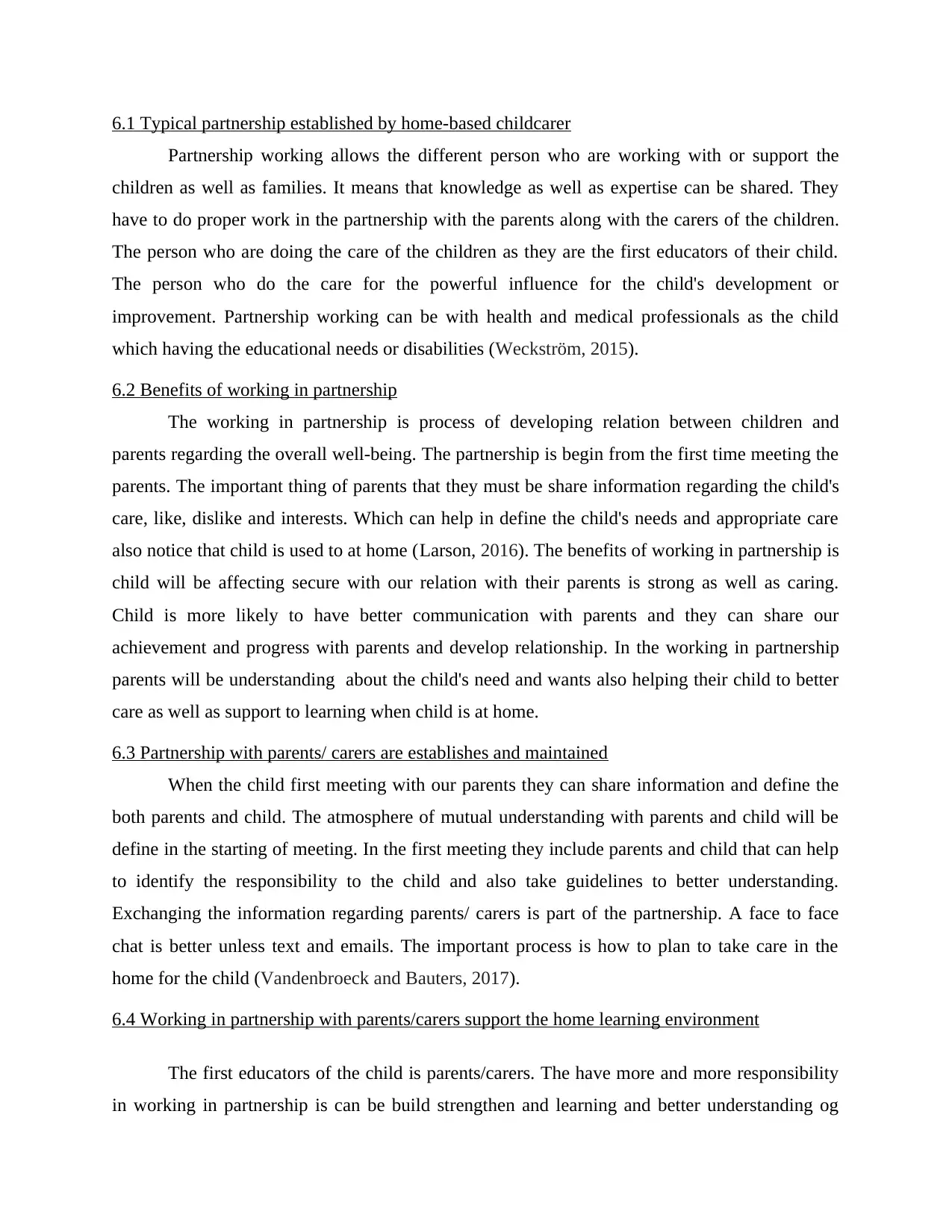
6.1 Typical partnership established by home-based childcarer
Partnership working allows the different person who are working with or support the
children as well as families. It means that knowledge as well as expertise can be shared. They
have to do proper work in the partnership with the parents along with the carers of the children.
The person who are doing the care of the children as they are the first educators of their child.
The person who do the care for the powerful influence for the child's development or
improvement. Partnership working can be with health and medical professionals as the child
which having the educational needs or disabilities (Weckström, 2015).
6.2 Benefits of working in partnership
The working in partnership is process of developing relation between children and
parents regarding the overall well-being. The partnership is begin from the first time meeting the
parents. The important thing of parents that they must be share information regarding the child's
care, like, dislike and interests. Which can help in define the child's needs and appropriate care
also notice that child is used to at home (Larson, 2016). The benefits of working in partnership is
child will be affecting secure with our relation with their parents is strong as well as caring.
Child is more likely to have better communication with parents and they can share our
achievement and progress with parents and develop relationship. In the working in partnership
parents will be understanding about the child's need and wants also helping their child to better
care as well as support to learning when child is at home.
6.3 Partnership with parents/ carers are establishes and maintained
When the child first meeting with our parents they can share information and define the
both parents and child. The atmosphere of mutual understanding with parents and child will be
define in the starting of meeting. In the first meeting they include parents and child that can help
to identify the responsibility to the child and also take guidelines to better understanding.
Exchanging the information regarding parents/ carers is part of the partnership. A face to face
chat is better unless text and emails. The important process is how to plan to take care in the
home for the child (Vandenbroeck and Bauters, 2017).
6.4 Working in partnership with parents/carers support the home learning environment
The first educators of the child is parents/carers. The have more and more responsibility
in working in partnership is can be build strengthen and learning and better understanding og
Partnership working allows the different person who are working with or support the
children as well as families. It means that knowledge as well as expertise can be shared. They
have to do proper work in the partnership with the parents along with the carers of the children.
The person who are doing the care of the children as they are the first educators of their child.
The person who do the care for the powerful influence for the child's development or
improvement. Partnership working can be with health and medical professionals as the child
which having the educational needs or disabilities (Weckström, 2015).
6.2 Benefits of working in partnership
The working in partnership is process of developing relation between children and
parents regarding the overall well-being. The partnership is begin from the first time meeting the
parents. The important thing of parents that they must be share information regarding the child's
care, like, dislike and interests. Which can help in define the child's needs and appropriate care
also notice that child is used to at home (Larson, 2016). The benefits of working in partnership is
child will be affecting secure with our relation with their parents is strong as well as caring.
Child is more likely to have better communication with parents and they can share our
achievement and progress with parents and develop relationship. In the working in partnership
parents will be understanding about the child's need and wants also helping their child to better
care as well as support to learning when child is at home.
6.3 Partnership with parents/ carers are establishes and maintained
When the child first meeting with our parents they can share information and define the
both parents and child. The atmosphere of mutual understanding with parents and child will be
define in the starting of meeting. In the first meeting they include parents and child that can help
to identify the responsibility to the child and also take guidelines to better understanding.
Exchanging the information regarding parents/ carers is part of the partnership. A face to face
chat is better unless text and emails. The important process is how to plan to take care in the
home for the child (Vandenbroeck and Bauters, 2017).
6.4 Working in partnership with parents/carers support the home learning environment
The first educators of the child is parents/carers. The have more and more responsibility
in working in partnership is can be build strengthen and learning and better understanding og
Paraphrase This Document
Need a fresh take? Get an instant paraphrase of this document with our AI Paraphraser
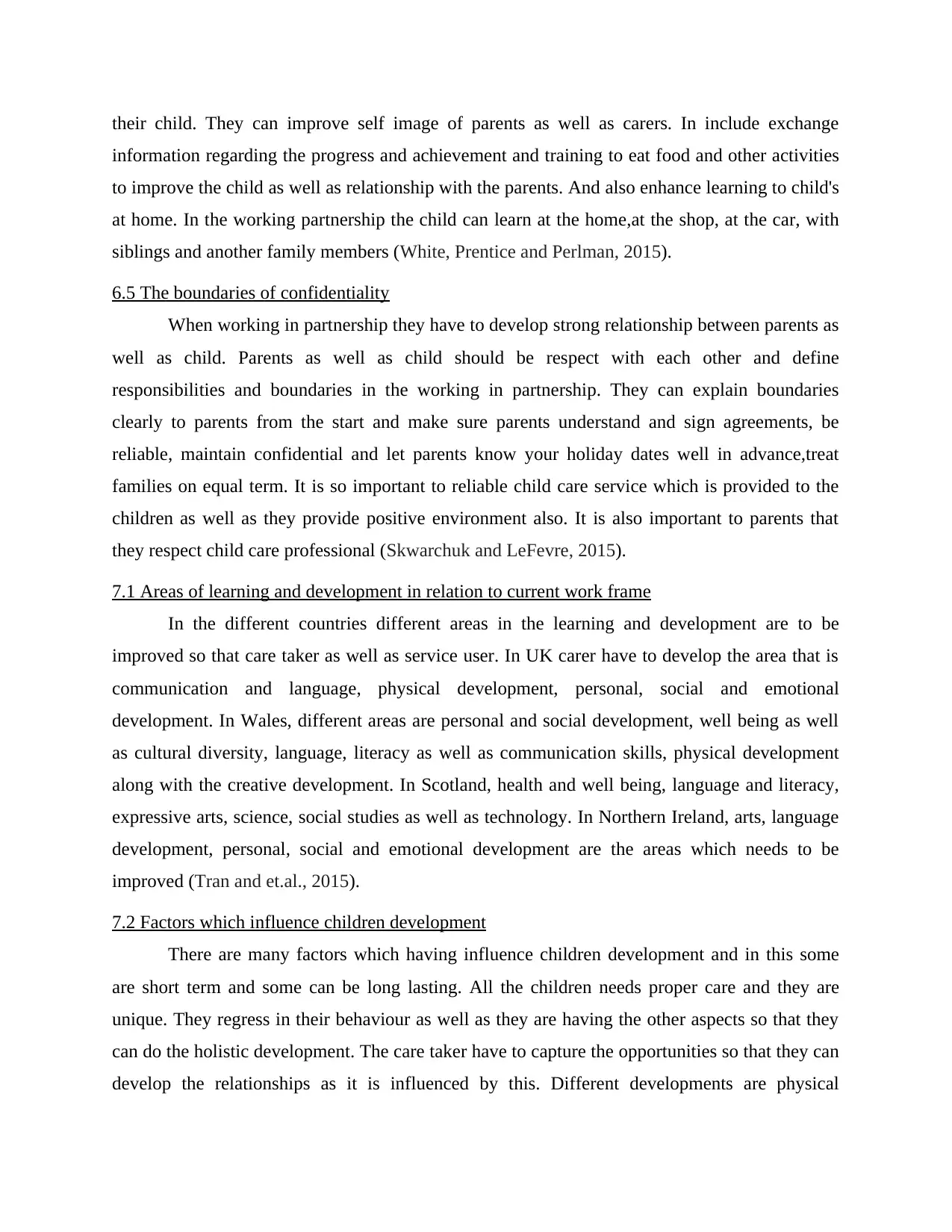
their child. They can improve self image of parents as well as carers. In include exchange
information regarding the progress and achievement and training to eat food and other activities
to improve the child as well as relationship with the parents. And also enhance learning to child's
at home. In the working partnership the child can learn at the home,at the shop, at the car, with
siblings and another family members (White, Prentice and Perlman, 2015).
6.5 The boundaries of confidentiality
When working in partnership they have to develop strong relationship between parents as
well as child. Parents as well as child should be respect with each other and define
responsibilities and boundaries in the working in partnership. They can explain boundaries
clearly to parents from the start and make sure parents understand and sign agreements, be
reliable, maintain confidential and let parents know your holiday dates well in advance,treat
families on equal term. It is so important to reliable child care service which is provided to the
children as well as they provide positive environment also. It is also important to parents that
they respect child care professional (Skwarchuk and LeFevre, 2015).
7.1 Areas of learning and development in relation to current work frame
In the different countries different areas in the learning and development are to be
improved so that care taker as well as service user. In UK carer have to develop the area that is
communication and language, physical development, personal, social and emotional
development. In Wales, different areas are personal and social development, well being as well
as cultural diversity, language, literacy as well as communication skills, physical development
along with the creative development. In Scotland, health and well being, language and literacy,
expressive arts, science, social studies as well as technology. In Northern Ireland, arts, language
development, personal, social and emotional development are the areas which needs to be
improved (Tran and et.al., 2015).
7.2 Factors which influence children development
There are many factors which having influence children development and in this some
are short term and some can be long lasting. All the children needs proper care and they are
unique. They regress in their behaviour as well as they are having the other aspects so that they
can do the holistic development. The care taker have to capture the opportunities so that they can
develop the relationships as it is influenced by this. Different developments are physical
information regarding the progress and achievement and training to eat food and other activities
to improve the child as well as relationship with the parents. And also enhance learning to child's
at home. In the working partnership the child can learn at the home,at the shop, at the car, with
siblings and another family members (White, Prentice and Perlman, 2015).
6.5 The boundaries of confidentiality
When working in partnership they have to develop strong relationship between parents as
well as child. Parents as well as child should be respect with each other and define
responsibilities and boundaries in the working in partnership. They can explain boundaries
clearly to parents from the start and make sure parents understand and sign agreements, be
reliable, maintain confidential and let parents know your holiday dates well in advance,treat
families on equal term. It is so important to reliable child care service which is provided to the
children as well as they provide positive environment also. It is also important to parents that
they respect child care professional (Skwarchuk and LeFevre, 2015).
7.1 Areas of learning and development in relation to current work frame
In the different countries different areas in the learning and development are to be
improved so that care taker as well as service user. In UK carer have to develop the area that is
communication and language, physical development, personal, social and emotional
development. In Wales, different areas are personal and social development, well being as well
as cultural diversity, language, literacy as well as communication skills, physical development
along with the creative development. In Scotland, health and well being, language and literacy,
expressive arts, science, social studies as well as technology. In Northern Ireland, arts, language
development, personal, social and emotional development are the areas which needs to be
improved (Tran and et.al., 2015).
7.2 Factors which influence children development
There are many factors which having influence children development and in this some
are short term and some can be long lasting. All the children needs proper care and they are
unique. They regress in their behaviour as well as they are having the other aspects so that they
can do the holistic development. The care taker have to capture the opportunities so that they can
develop the relationships as it is influenced by this. Different developments are physical

development, intellectual or cognitive development, language as well as communication
development and social and emotional development (Burrows and Bredin, 2015).
7.3 Difference between sequence of development and rate of development
Sequence is the order so that they can do all the developments which are needed where as
rate is the speed which happens at the time of providing care to the children. For example:
Sequence is a physical development of a baby which begins with a rolling up over than sit up,
crawl, walk as well as run. All these elements which assist in doing the developments so that all
the work is in still process by using the appropriate pattern (Havnes and Mogstad, 2015). But on
the other side, rate is that where one baby may achieve walking at the age of 10 months and may
accomplish at 12 months as well as another at 16 months. Sequence among all the children by
giving care are common but on the other side, rate is that in which they can develop or improve
these skills which are different in nature.
7.4 Describe key milestones in development for children from birth to 12 years
In the different developments key milestones are:
Physical development: In 16 to 21 months, the child have to builds a tower of two or
three blocks. Children having canine teeth erupt. They makes marks with crayons. They have to
feeds self by using a spoon. In 24 months, child shows the preferred hand, they begins to show a
bladder as well as control of bowel. Along with this they have to builds a tower of five or six
blocks. In 48 months, when they are running, they have to develop the skills and change the
direction. In 6-7 years, they moves to a meaningful ways to music. They have to use small
construction toys so that they can make skilful models (Chiam, 2015).
Intellectual and cognitive development: There are different ways which helps children in
learning the different things. Along with this it assist in improving the imagination and creativity.
It also improves the memory skills.
Language and communication development: To do the effective communication there are
different ways which children can use. Child make there own needs, express their own feelings
as well as describe the events. They play a crucial part in the development. In the age of 7-12
years they are competently uses spoken and written language. It enjoys to make up the stories
and telling jokes.
Social and emotional development: These developments are the building blocks of the
future success in life. Social development is learning to be with and relate to other people.
development and social and emotional development (Burrows and Bredin, 2015).
7.3 Difference between sequence of development and rate of development
Sequence is the order so that they can do all the developments which are needed where as
rate is the speed which happens at the time of providing care to the children. For example:
Sequence is a physical development of a baby which begins with a rolling up over than sit up,
crawl, walk as well as run. All these elements which assist in doing the developments so that all
the work is in still process by using the appropriate pattern (Havnes and Mogstad, 2015). But on
the other side, rate is that where one baby may achieve walking at the age of 10 months and may
accomplish at 12 months as well as another at 16 months. Sequence among all the children by
giving care are common but on the other side, rate is that in which they can develop or improve
these skills which are different in nature.
7.4 Describe key milestones in development for children from birth to 12 years
In the different developments key milestones are:
Physical development: In 16 to 21 months, the child have to builds a tower of two or
three blocks. Children having canine teeth erupt. They makes marks with crayons. They have to
feeds self by using a spoon. In 24 months, child shows the preferred hand, they begins to show a
bladder as well as control of bowel. Along with this they have to builds a tower of five or six
blocks. In 48 months, when they are running, they have to develop the skills and change the
direction. In 6-7 years, they moves to a meaningful ways to music. They have to use small
construction toys so that they can make skilful models (Chiam, 2015).
Intellectual and cognitive development: There are different ways which helps children in
learning the different things. Along with this it assist in improving the imagination and creativity.
It also improves the memory skills.
Language and communication development: To do the effective communication there are
different ways which children can use. Child make there own needs, express their own feelings
as well as describe the events. They play a crucial part in the development. In the age of 7-12
years they are competently uses spoken and written language. It enjoys to make up the stories
and telling jokes.
Social and emotional development: These developments are the building blocks of the
future success in life. Social development is learning to be with and relate to other people.
⊘ This is a preview!⊘
Do you want full access?
Subscribe today to unlock all pages.

Trusted by 1+ million students worldwide
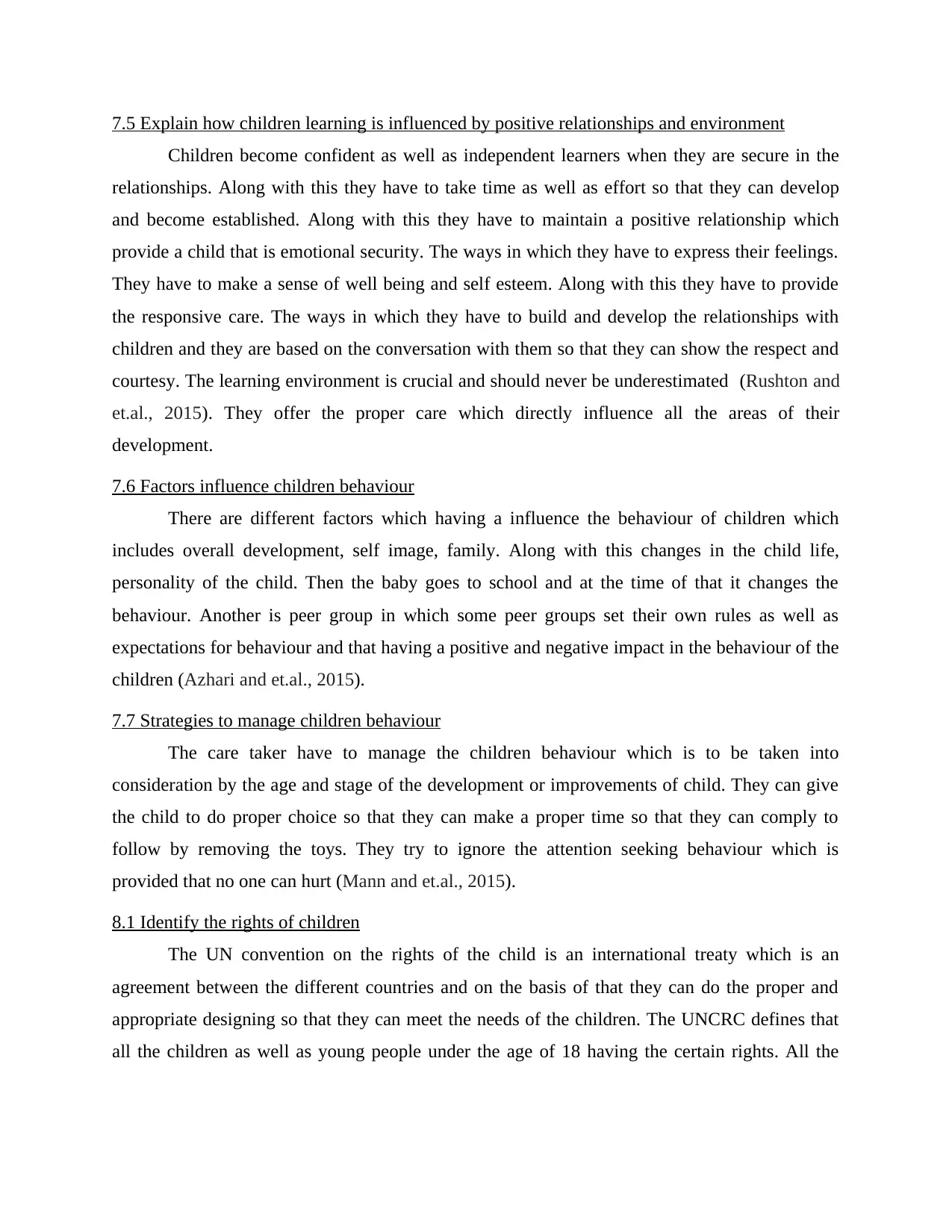
7.5 Explain how children learning is influenced by positive relationships and environment
Children become confident as well as independent learners when they are secure in the
relationships. Along with this they have to take time as well as effort so that they can develop
and become established. Along with this they have to maintain a positive relationship which
provide a child that is emotional security. The ways in which they have to express their feelings.
They have to make a sense of well being and self esteem. Along with this they have to provide
the responsive care. The ways in which they have to build and develop the relationships with
children and they are based on the conversation with them so that they can show the respect and
courtesy. The learning environment is crucial and should never be underestimated (Rushton and
et.al., 2015). They offer the proper care which directly influence all the areas of their
development.
7.6 Factors influence children behaviour
There are different factors which having a influence the behaviour of children which
includes overall development, self image, family. Along with this changes in the child life,
personality of the child. Then the baby goes to school and at the time of that it changes the
behaviour. Another is peer group in which some peer groups set their own rules as well as
expectations for behaviour and that having a positive and negative impact in the behaviour of the
children (Azhari and et.al., 2015).
7.7 Strategies to manage children behaviour
The care taker have to manage the children behaviour which is to be taken into
consideration by the age and stage of the development or improvements of child. They can give
the child to do proper choice so that they can make a proper time so that they can comply to
follow by removing the toys. They try to ignore the attention seeking behaviour which is
provided that no one can hurt (Mann and et.al., 2015).
8.1 Identify the rights of children
The UN convention on the rights of the child is an international treaty which is an
agreement between the different countries and on the basis of that they can do the proper and
appropriate designing so that they can meet the needs of the children. The UNCRC defines that
all the children as well as young people under the age of 18 having the certain rights. All the
Children become confident as well as independent learners when they are secure in the
relationships. Along with this they have to take time as well as effort so that they can develop
and become established. Along with this they have to maintain a positive relationship which
provide a child that is emotional security. The ways in which they have to express their feelings.
They have to make a sense of well being and self esteem. Along with this they have to provide
the responsive care. The ways in which they have to build and develop the relationships with
children and they are based on the conversation with them so that they can show the respect and
courtesy. The learning environment is crucial and should never be underestimated (Rushton and
et.al., 2015). They offer the proper care which directly influence all the areas of their
development.
7.6 Factors influence children behaviour
There are different factors which having a influence the behaviour of children which
includes overall development, self image, family. Along with this changes in the child life,
personality of the child. Then the baby goes to school and at the time of that it changes the
behaviour. Another is peer group in which some peer groups set their own rules as well as
expectations for behaviour and that having a positive and negative impact in the behaviour of the
children (Azhari and et.al., 2015).
7.7 Strategies to manage children behaviour
The care taker have to manage the children behaviour which is to be taken into
consideration by the age and stage of the development or improvements of child. They can give
the child to do proper choice so that they can make a proper time so that they can comply to
follow by removing the toys. They try to ignore the attention seeking behaviour which is
provided that no one can hurt (Mann and et.al., 2015).
8.1 Identify the rights of children
The UN convention on the rights of the child is an international treaty which is an
agreement between the different countries and on the basis of that they can do the proper and
appropriate designing so that they can meet the needs of the children. The UNCRC defines that
all the children as well as young people under the age of 18 having the certain rights. All the
Paraphrase This Document
Need a fresh take? Get an instant paraphrase of this document with our AI Paraphraser
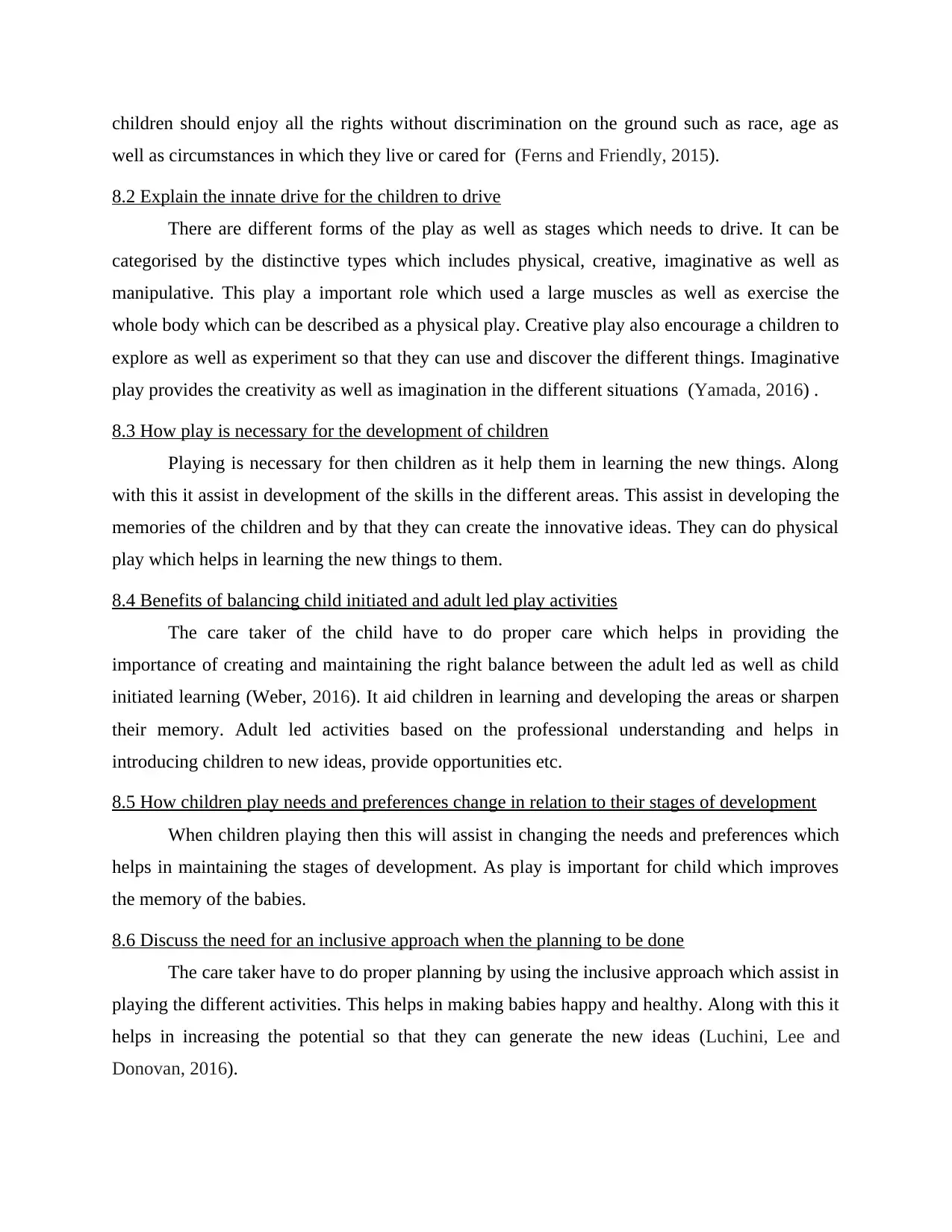
children should enjoy all the rights without discrimination on the ground such as race, age as
well as circumstances in which they live or cared for (Ferns and Friendly, 2015).
8.2 Explain the innate drive for the children to drive
There are different forms of the play as well as stages which needs to drive. It can be
categorised by the distinctive types which includes physical, creative, imaginative as well as
manipulative. This play a important role which used a large muscles as well as exercise the
whole body which can be described as a physical play. Creative play also encourage a children to
explore as well as experiment so that they can use and discover the different things. Imaginative
play provides the creativity as well as imagination in the different situations (Yamada, 2016) .
8.3 How play is necessary for the development of children
Playing is necessary for then children as it help them in learning the new things. Along
with this it assist in development of the skills in the different areas. This assist in developing the
memories of the children and by that they can create the innovative ideas. They can do physical
play which helps in learning the new things to them.
8.4 Benefits of balancing child initiated and adult led play activities
The care taker of the child have to do proper care which helps in providing the
importance of creating and maintaining the right balance between the adult led as well as child
initiated learning (Weber, 2016). It aid children in learning and developing the areas or sharpen
their memory. Adult led activities based on the professional understanding and helps in
introducing children to new ideas, provide opportunities etc.
8.5 How children play needs and preferences change in relation to their stages of development
When children playing then this will assist in changing the needs and preferences which
helps in maintaining the stages of development. As play is important for child which improves
the memory of the babies.
8.6 Discuss the need for an inclusive approach when the planning to be done
The care taker have to do proper planning by using the inclusive approach which assist in
playing the different activities. This helps in making babies happy and healthy. Along with this it
helps in increasing the potential so that they can generate the new ideas (Luchini, Lee and
Donovan, 2016).
well as circumstances in which they live or cared for (Ferns and Friendly, 2015).
8.2 Explain the innate drive for the children to drive
There are different forms of the play as well as stages which needs to drive. It can be
categorised by the distinctive types which includes physical, creative, imaginative as well as
manipulative. This play a important role which used a large muscles as well as exercise the
whole body which can be described as a physical play. Creative play also encourage a children to
explore as well as experiment so that they can use and discover the different things. Imaginative
play provides the creativity as well as imagination in the different situations (Yamada, 2016) .
8.3 How play is necessary for the development of children
Playing is necessary for then children as it help them in learning the new things. Along
with this it assist in development of the skills in the different areas. This assist in developing the
memories of the children and by that they can create the innovative ideas. They can do physical
play which helps in learning the new things to them.
8.4 Benefits of balancing child initiated and adult led play activities
The care taker of the child have to do proper care which helps in providing the
importance of creating and maintaining the right balance between the adult led as well as child
initiated learning (Weber, 2016). It aid children in learning and developing the areas or sharpen
their memory. Adult led activities based on the professional understanding and helps in
introducing children to new ideas, provide opportunities etc.
8.5 How children play needs and preferences change in relation to their stages of development
When children playing then this will assist in changing the needs and preferences which
helps in maintaining the stages of development. As play is important for child which improves
the memory of the babies.
8.6 Discuss the need for an inclusive approach when the planning to be done
The care taker have to do proper planning by using the inclusive approach which assist in
playing the different activities. This helps in making babies happy and healthy. Along with this it
helps in increasing the potential so that they can generate the new ideas (Luchini, Lee and
Donovan, 2016).
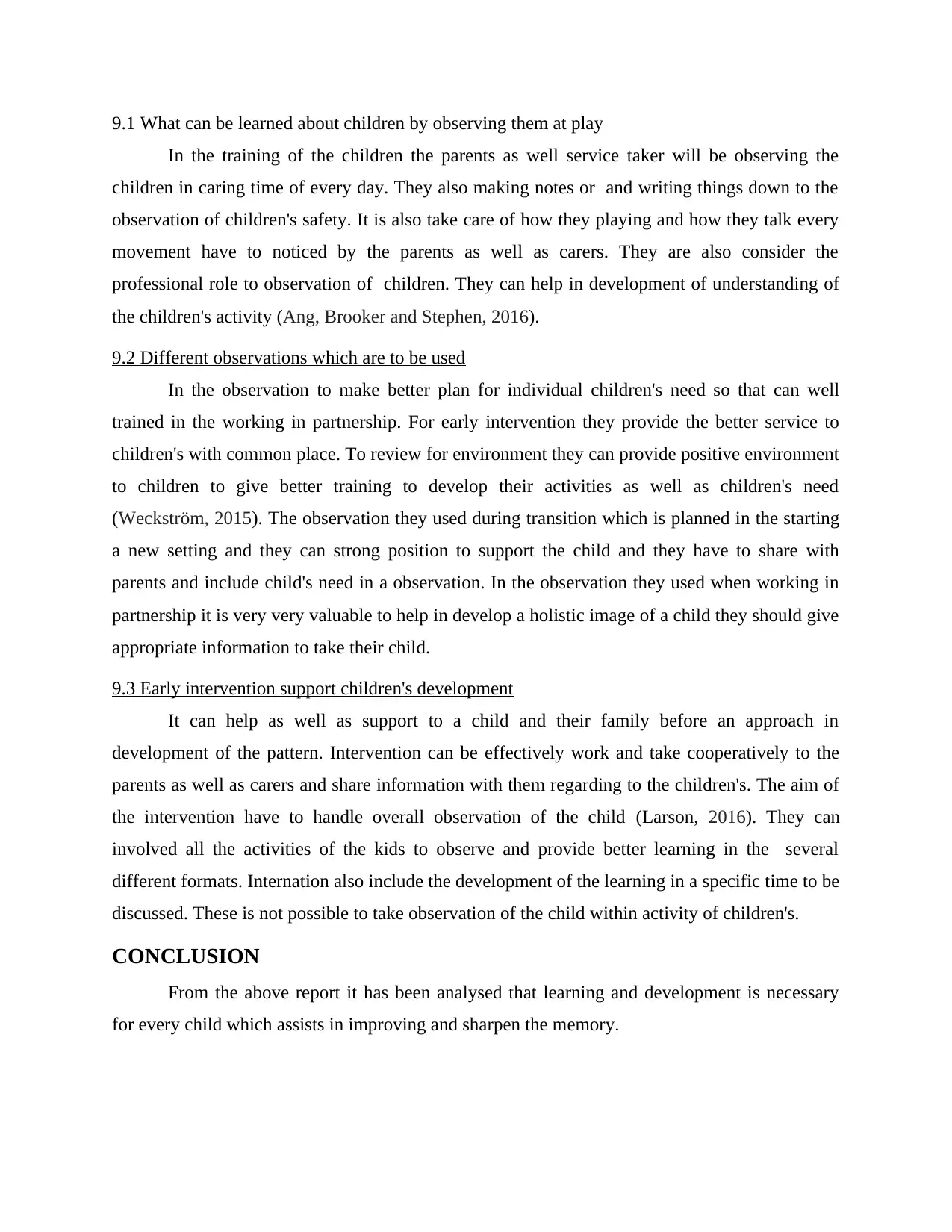
9.1 What can be learned about children by observing them at play
In the training of the children the parents as well service taker will be observing the
children in caring time of every day. They also making notes or and writing things down to the
observation of children's safety. It is also take care of how they playing and how they talk every
movement have to noticed by the parents as well as carers. They are also consider the
professional role to observation of children. They can help in development of understanding of
the children's activity (Ang, Brooker and Stephen, 2016).
9.2 Different observations which are to be used
In the observation to make better plan for individual children's need so that can well
trained in the working in partnership. For early intervention they provide the better service to
children's with common place. To review for environment they can provide positive environment
to children to give better training to develop their activities as well as children's need
(Weckström, 2015). The observation they used during transition which is planned in the starting
a new setting and they can strong position to support the child and they have to share with
parents and include child's need in a observation. In the observation they used when working in
partnership it is very very valuable to help in develop a holistic image of a child they should give
appropriate information to take their child.
9.3 Early intervention support children's development
It can help as well as support to a child and their family before an approach in
development of the pattern. Intervention can be effectively work and take cooperatively to the
parents as well as carers and share information with them regarding to the children's. The aim of
the intervention have to handle overall observation of the child (Larson, 2016). They can
involved all the activities of the kids to observe and provide better learning in the several
different formats. Internation also include the development of the learning in a specific time to be
discussed. These is not possible to take observation of the child within activity of children's.
CONCLUSION
From the above report it has been analysed that learning and development is necessary
for every child which assists in improving and sharpen the memory.
In the training of the children the parents as well service taker will be observing the
children in caring time of every day. They also making notes or and writing things down to the
observation of children's safety. It is also take care of how they playing and how they talk every
movement have to noticed by the parents as well as carers. They are also consider the
professional role to observation of children. They can help in development of understanding of
the children's activity (Ang, Brooker and Stephen, 2016).
9.2 Different observations which are to be used
In the observation to make better plan for individual children's need so that can well
trained in the working in partnership. For early intervention they provide the better service to
children's with common place. To review for environment they can provide positive environment
to children to give better training to develop their activities as well as children's need
(Weckström, 2015). The observation they used during transition which is planned in the starting
a new setting and they can strong position to support the child and they have to share with
parents and include child's need in a observation. In the observation they used when working in
partnership it is very very valuable to help in develop a holistic image of a child they should give
appropriate information to take their child.
9.3 Early intervention support children's development
It can help as well as support to a child and their family before an approach in
development of the pattern. Intervention can be effectively work and take cooperatively to the
parents as well as carers and share information with them regarding to the children's. The aim of
the intervention have to handle overall observation of the child (Larson, 2016). They can
involved all the activities of the kids to observe and provide better learning in the several
different formats. Internation also include the development of the learning in a specific time to be
discussed. These is not possible to take observation of the child within activity of children's.
CONCLUSION
From the above report it has been analysed that learning and development is necessary
for every child which assists in improving and sharpen the memory.
⊘ This is a preview!⊘
Do you want full access?
Subscribe today to unlock all pages.

Trusted by 1+ million students worldwide
1 out of 14
Related Documents
Your All-in-One AI-Powered Toolkit for Academic Success.
+13062052269
info@desklib.com
Available 24*7 on WhatsApp / Email
![[object Object]](/_next/static/media/star-bottom.7253800d.svg)
Unlock your academic potential
Copyright © 2020–2025 A2Z Services. All Rights Reserved. Developed and managed by ZUCOL.





